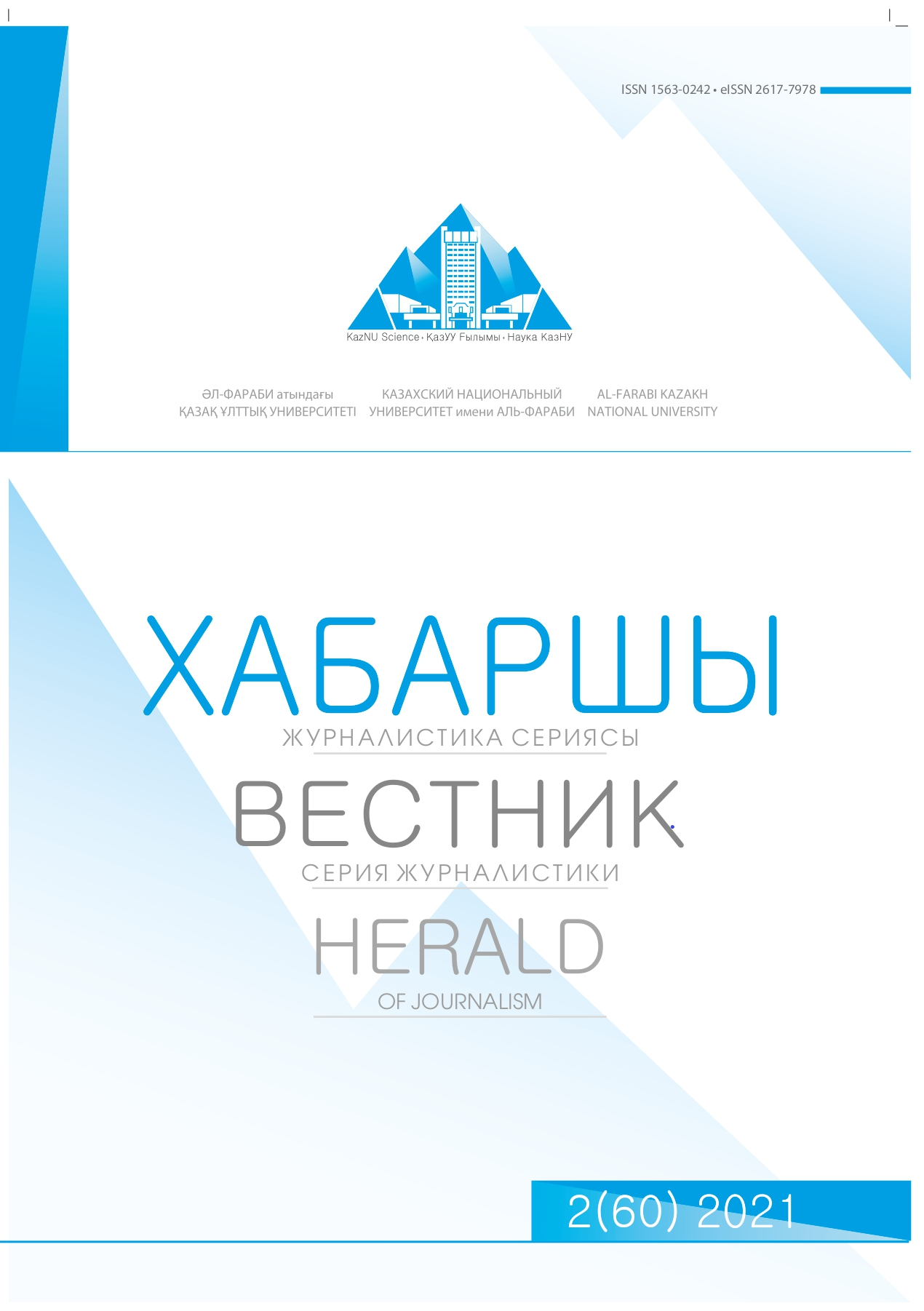Potential of Dianchronous Communication of News Broadcasting on the Example of the TengriTV Online Channel
DOI:
https://doi.org/10.26577/HJ.2021.v60.i2.05Abstract
The topic of this study is related to the need to study changes in the usual documentary genres in the context of the new online broadcasting. Today, a chronicle is primarily perceived as a visual document from the past that is used as a quote or illustration in a documentary. However, being a small form of documentary filmmaking, the chronicle became the prototype of the usual news television broadcasting, which today is undergoing changes in online broadcasting, and therefore requires a separate study. The purpose of the study is to discover the possibilities of information broadcasting to continue the traditions of documentary chronicle. The main direction of scientific research was the problem of the identity of the genre of the chronicle in modern conditions. The scientific significance of the study is due to the need to systematize knowledge about the chronicle as a documentary genre in the network broadcast- ing system on the Internet. The practical significance of the work is explained by objective conclusions, which can serve as a basis for the creation of documentaries and information videos, taking into account the need to preserve in them the possibilities for asynchronous communication. The research method- ology is based on a content analysis of informational video materials of the TengtiTV online channel as an example of online broadcasting. The main results of the study show that information videos and recordings of live broadcasts carry the potential of asynchronous communication, and along with this, they have such characteristic features of the chronicle as impersonality and the presence of signs of the time. As a result of the study, it was revealed that online information broadcasting is a «classic» type of
chronicle. The important features of the newsreel are such characteristics as impersonality, simple pre- sentation, reflection of the portrait of time, potential for citation.
Key words: newsreel, news story, information portal.
References
Беляев И.К. Монолог о главном // Современный российский форматный документальный телефильм. Сборник научных статей. – М.: Ф-т журн. МГУ, 2017. – С. 98-101.
Борисов С.И. Технология создания документального фильма. ‒ М.: Директ-Медиа, 2019. – С. 80. Baechlin P. Newsreels across the world. – Paris: UNESCO, 1952. – P. 9.
Chambers C. Researching Newsreels. Local, National and Transnational Case Studies. – London: Palgrave Macmillan, 2018. – P.
Fielding R. The American Newsreel: A Complete History, 1911-1967. – Jefferson: McFarland & Company, 2006. – P. 1.
Кемарская И.Н. Особенности драматургии научно-развлекательной ТВ-программы // Масс-медиа в мультимедийной среде. Основные проблемы и зоны риска. Научный сборник под редакцией С.Л. Уразовой. Серия «Пространство медиакоммуникаций». – М.: Академия медиаиндустрии, 2014. – С. 65-78.
Муратов С.А. Пристрастная камера. – М.: Аспект-Пресс 2004. – С. 20-81.
Mäder M.-T. Between Migration and Integration. Representing Religious Boundaries in Swiss Documentaries // Constructions of Cultural Identities in Newsreel Cinema and Television after 1945. – Wetzlar: Majuskel Medienproduktion GmbH, 2016. – P. 157. Malitsky J. Post-Revolution Nonfiction Film: Building the Soviet and Cuban Nations. – Indiana: Indiana University Press,
2013. – P. 202.
Nichols B. Introduction to documentary. – Indiana: Bloomington, 2010 – P. 146. Прожико Г.С. Экран мировой документалистики. – М.: ВГИК, 2011. – С. 8.
Пронин А.А. Mass-док: презумпция нарративности. – СПб.: ИД Петрополис, 2017. – С. 10-166. Posetti J. Journalis, «fake news» & disinformation. – Paris: UNESCO, 2018 – P. 59.
Шергова К.А. Становление жанров документального телекино (1960-е – начало 2000-х гг.). – М.: Академия медиаиндустрии, 2016 – С. 50-70.
Wiehl A. The «New» Documentary Nexus – Networked|Networking in Interactive Assemblages. – Newcastle: Cambridge Scholars, 2019. – P. 4.
References
Belyayev I.K. (2017) Monolog o glavnom // Sovremennyy rossiyskiy format dokumental’nogo telefil’ma [Monologue about the main thing // Modern Russian formatted documentary television film]. pp. 98-101.
Borisov S.I. (2019) Tekhnologiya sozdaniya dokumental’nogo fil’ma [Technology for making a documentary film]. M .: Direkt- Media, p. 80.
Baechlin P. (1952). Newsreels across the world. Paris: UNESCO, p. 9.
Chambers C. (2018). Researching Newsreels. Local, National and Transnational Case Studies. London: Palgrave Macmillan, p. 77. Fielding R. (2006). The American Newsreel: A Complete History, 1911-1967. Jefferson: McFarland & Company, p. 1.
Kemarskaya I.N. (2014) Osobennosti dramaturgii nauchno-razvlekatel’noy teleprogrammy // SMI v mul’timediynoy srede. Os- novnyye problemy i zony riska [Features of the drama of a scientific and entertainment TV program // Mass media in a multimedia environment. Main problems and risk areas]. pp. 65-78.
Muratov S.A. (2004) Smeshchennaya kamera [Biased camera]. M .: Aspekt-Press, pp. 20-81.
Mäder M.-T. (2016). Between Migration and Integration. Representing Religious Boundaries in Swiss Documentaries // Con- structions of Cultural Identities in Newsreel Cinema and Television after 1945. Wetzlar: Majuskel Medienproduktion GmbH, p. 157.
Malitsky J. (2013). Post-Revolution Nonfiction Film: Building the Soviet and Cuban Nations. Indiana: Indiana University Press, p. 202. Nichols B. (2010). Introduction to documentary. Indiana: Bloomington, p. 146.
Prozhiko G.S. (2011) Ekran mirovogo dokumental’nogo kino [World Documentary Screen]. M .: VGIK, p. 8.
Pronin A.A. (2017) Mass-doc: Prezumptsiya narrativa [Mass-doc: the presumption of narrative]. SPb .: ID Petropolis, pp. 10-166. Posetti J. (2018). Journalis, «fake news» & disinformation. Paris: UNESCO, p. 59.
Shergova K.A. (2016) Vozniknoveniye zhanrov dokumental’nogo televideniya (1960-ye ‒ nachalo 2000-kh) [Formation of genres of documentary telecine (1960s ‒ early 2000s)]. M .: Akademiya mediaindustrii, pp. 50-70.
Wiehl A. (2019). The «New» Documentary Nexus – Networked|Networking in Interactive Assemblages. Newcastle: Cambridge Scholars, p. 4.




